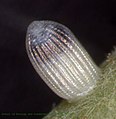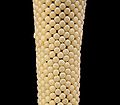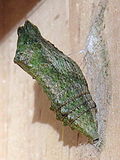Entomology/Lepidoptera
Table of Contents
[edit | edit source]- Introduction
- What are insects?
- Common insects
- Other insects
- What are arachnids?
- Common arachnids
- Other arachnids
Lepidoptera includes butterflies, moths, and skippers.
Development
[edit | edit source]Butterflies undergo complete metamorphosis, that includes four stages: egg, larva (caterpillar), pupa (chrysalis), and adult (imago).
Egg
[edit | edit source]Eggs are extremely varied among lepidopterans. Many species can be identified by their eggs. Eggs are generally laid on the host plants of lepidopterans, so that once hatched the larva will have a food supply.
Caterpillar
[edit | edit source]Like other larvae, the only purpose of this stage is growth. During this stage the caterpillar spends most of its time eating. In this stage, the caterpillar's anatomy is quite simple. Its eyes are very simple, only capable of determining light from dark. The caterpillar has 3 pairs of true legs located on its thorax, and 5 pairs of false legs called prolegs on its abdomen. Also, the digestive tract is particularly pronounced in this stage, making up most of the internal organs of the caterpillar. The appearance of caterpillars is also quite varied. Some are described as "worms," with only bare, plain-coloured bodies. Some are bare, but have more brightly coloured bodies. Others have hair or spines that have poisons that aid in self-defense.
Chrysalis
[edit | edit source]
After a number of growth periods, called instars, a caterpillar will find a spot, often a plant (other species may burrow into the ground), and forms a pupa. The lepidopteran may form something called a cremaster so that it remains attached to the plant it has chosen. The cremaster is made of silk. Species called silkmoths will spin a cocoon made of silk. The pupa of a lepidoptera is called a chrysalis. During this stage a process called histolysis occurs, in which the organs of the caterpillar "dissolve" and reform in a process called histogenesis. Many species overwinter in this form.














